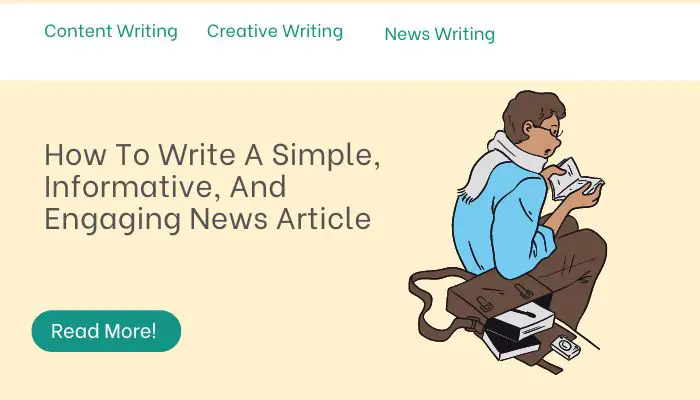If you want to write for the news, start by thinking about it as a conversation with your reader. How can you share something meaningful and informative with them?
And how can you keep them engaged enough that they’ll want to read more? In this article, I’ll show you some tips and tricks for writing engaging news articles that anyone can use!
| Takeaway |
|---|
| 1. Keep it Simple: Focus on delivering news articles with a clear and straightforward writing style. Avoid unnecessary jargon and complicated language to ensure readers can easily understand the content. |
| 2. Informative Content: Provide valuable and accurate information in your news articles. Research thoroughly and cite credible sources to enhance the credibility of your writing. |
| 3. Engaging Headlines: Craft attention-grabbing headlines that entice readers to click and read the full article. A compelling headline can make a significant difference in attracting an audience. |
| 4. Concise and Relevant: Present the most important information early in the article and follow a logical structure. Keep the content concise and relevant to maintain readers’ interest throughout. |
| 5. Captivate with Storytelling: Incorporate storytelling elements to make your news articles more captivating. Use anecdotes, quotes, and narratives to create a connection with your audience. |
1. Write A News Article
The first step to writing a news article is to write the news article.
You’ll want to ensure that your writing style is as simple and engaging as possible, because this will make it easier for readers to understand what you’re trying to say.
To accomplish this, keep your sentences short, use simple vocabulary and sentence structure when possible, and don’t use complicated punctuation or grammar rules unless absolutely necessary.
Discover how ghostwriting can open doors to high-paying freelance writing opportunities by honing your skills as a ghostwriter. Our guide on how ghostwriting can help you land high-paying freelance writing jobs unveils the secrets to success in this lucrative field.
2. Title Your Article
Your article’s title is a very important part of your news story, so don’t skimp on the details! It should be short and sweet, but descriptive.
You should also make sure to use active voice by using verbs like “is” or “have.” Using the present tense will keep you from sounding like an old-timey newspaper writer.
In this case, a question is best because it’s eye-catching and will hopefully catch the reader’s attention enough for them to click through and read more.
Just remember that whatever you write in your title must be relevant to what comes after it!
3. Use The Right Style Of Writing
Here are some tips to help you write in a way that’s accessible and easy to understand:
Use the active voice instead of passive. The active voice focuses on the subject of a sentence, while the passive voice focuses on an object or other person/thing.
For example, “The dog was bitten by a raccoon” uses the active voice because it emphasizes who did what (the dog was bitten).
In contrast, “A raccoon bit the dog” uses passive because it emphasizes what happened (that something happened to someone else). This can be confusing for readers who don’t know what’s happening in each sentence.
Use correct tense throughout your article so that your audience knows when events occurred or will occur in relation to each other as well as any current happenings related to them.
This helps keep stories clear and consistent even if they’re about things that happened long ago or might happen soon!
Make sure pronouns agree with their antecedents (the nouns they refer back too). You don’t want anyone thinking “Who did what?” or “What’s going on here?!”
After reading something written poorly; this problem often occurs when writers leave out essential information necessary for understanding sentences’ meanings fully.”
Master the art of article writing with our comprehensive and practical unofficial guide on how to write an article. From crafting captivating introductions to structuring your content flawlessly, this guide has everything you need to become a skilled writer.
4. Lead With Action
Start with a verb. This is the first step in writing an engaging article, and it’s one that many writers forget. A lot of times, writers will start their articles with descriptions or adjectives instead of verbs this can make your news piece feel more like a novel than an informative article.
Here are some tips for choosing the right verb:
Use active voice whenever possible (e.g., “John punched Steve in the face” vs “Steve was punched by John in the face”).
Active voices tend to be more vibrant and exciting than passive voices, which have a tendency towards being boring or confusingly complex because they’re trying to avoid pronouns like “he” or “she.”
Choose a verb that’s relevant to your topic matter (e.g., “John hits Steve” rather than “There is fighting”). You want your opening sentence to immediately draw readers into what they care about most about your story!
5. Be Factual And Concise
A news article should be factual and concise. Don’t use more words than necessary; each word should convey a distinct point. Use the facts you’ve gathered to support your argument.
Also, don’t include any opinion unless it’s supported by facts or statistics. If anyone reading your article has doubts about whether or not they believe what you’re saying, they’ll be less likely to trust anything else in the article.
This is especially important if there’s any risk of bias on your part which is always a risk, but especially so when writing about controversial topics such as race relations or immigration policy!
Elevate your news writing game with 15 invaluable tips for creating high-quality news articles. From impeccable fact-checking to crafting attention-grabbing headlines, our guide has got you covered for writing compelling news pieces.
6. Do Not Add New Information In The Conclusion
A conclusion is the last paragraph of a news article, and it should not be used as an opportunity to add new information or ideas. Don’t try to impress the reader by introducing new concepts or providing more information about something that was already discussed in the body.
Instead, summarize what you have already written (make sure it is concise) and wrap things up so that your article can be read quickly and easily. The conclusion should always be the last sentence of its paragraph, sometimes even taking up only one sentence:
It was reported yesterday that many small businesses were facing difficulties with their credit card processing services due to recent regulations issued by the federal government.
These changes have been causing some companies to lose business as they are unable to accept payments through various methods such as checks or cashier’s checks…
As a blogger, it’s essential to master the art of writing engaging news articles. Check out the blogger’s guide to writing great news articles for valuable insights into creating share-worthy content that keeps your readers coming back for more.
7. Ask Questions To The Reader
You can also use questions to engage the reader and make your writing more interesting, which will help you build a relationship with them. Asking questions is a great way of making your writing more informative, as well as giving you an opportunity to explain something in detail.
The key thing to remember when including questions in a news article is that it’s important not to overdo it – as soon as readers see one or two questions they’ll get bored and lose interest! You don’t want that!
8. Use Media, If You Can
A picture is worth a thousand words, but in the context of an article, it’s usually worth about 250-300. Images are great for:
Adding visual interest to your story. If your story is about a new type of bird that has been spotted in a forest and you have no photos of it yet, then don’t use one! But if you do have images available or can access them easily.
Then go ahead and include them as part of your story. Readers love pictures because they break up text and make reading easier for their brains (and eyes).
They also allow readers some flexibility in terms of what they choose to read first; depending on how many images are included in your piece, readers may scan through them before deciding where to start reading or which ones deserve more attention than others.
Want your news stories to reach millions of readers? Unlock the secrets of writing captivating news pieces with our guide on writing great news stories that get read by millions. From powerful storytelling to effective distribution, we’ve got you covered on all fronts.
Conclusion
The truth is, there’s no magic formula for creating good journalism. But as you learn more about the craft, you’ll make your own discoveries about what works for you. In the meantime, keep these tips in mind:
- Be concise and clear
- Inform your reader in a way that feels natural to the
- Make sure your article is engaging enough so they want to read it! You can do this by using verbs like “explore” or “discover” instead of bland nouns like “thingy” or “thingamabobber.”
Further Reading
How to Write an Article for a Newspaper: Learn the essentials of crafting compelling articles for newspapers, covering topics that matter and engaging readers effectively.
How to Write an Amazing Feature Article: Discover the art of writing captivating feature articles that delve deep into stories, providing unique perspectives that resonate with readers.
Captivating News Articles: Tips and Tricks: Uncover the secrets to creating captivating news articles that grab attention, present information concisely, and leave a lasting impact on your audience.
FAQs
How to Write an Article for a Newspaper?
Crafting an article for a newspaper involves following specific guidelines to ensure your content fits the format and engages readers effectively. Begin with a compelling headline, focus on newsworthy topics, and maintain a clear and concise writing style.
What Makes a Feature Article Amazing?
An amazing feature article goes beyond reporting facts; it tells a captivating story, presents unique angles, and evokes emotions in readers. Using descriptive language, incorporating quotes, and conducting thorough research are essential for creating an outstanding feature.
How Can I Write Captivating News Articles?
To write captivating news articles, start with a catchy headline that piques curiosity. Focus on the most important information in the opening paragraphs and structure the content logically. Use strong, concise language and verify the accuracy of facts before publishing.
What Differentiates a Newspaper Article from Other Types?
Newspaper articles are typically written in a straightforward, objective style, presenting factual information about recent events. Unlike opinion pieces or feature articles, newspapers prioritize delivering news concisely and without bias.
How to Keep Readers Engaged in News Articles?
To keep readers engaged in news articles, use attention-grabbing headlines, relevant images, and concise writing. Present the most crucial information first and provide additional context as the article progresses. Ensuring accuracy and credibility also fosters reader trust and engagement.

Costantine Edward is a digital marketing expert, freelance writer, and entrepreneur who helps people attain financial freedom. I’ve been working in marketing since I was 18 years old and have managed to build a successful career doing what I love.
